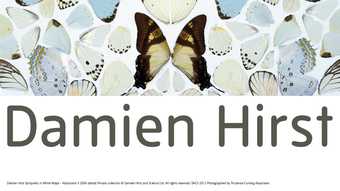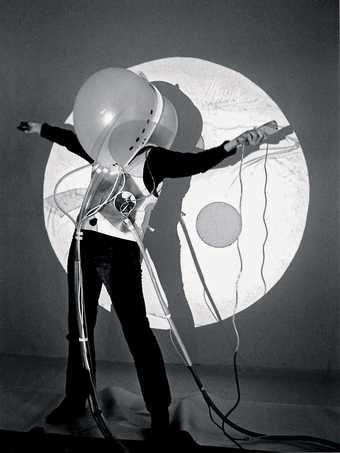
Coop Himmelb(l)au
The White Suit project 1969
Courtesy Coop Himmelb(l)au
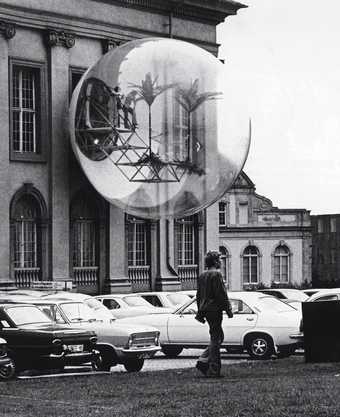
Hans-Rucker-Co
Oasis 7 at documenta 5, Kassel 1972
Photo: Günter Zamp Kelp
Courtesy Hans-Rucker-Co
Gertrude Stein wrote in her 1935 essay Pictures that in a painting there should be “no air… no feeling of air”. Ruskin disagreed, on the grounds that “everything that is needful, nourishing and delightful about the earth comes from its capacity to take up oxygen – to rust: It is not a fault in the iron, but a virtue, to be so fond of getting rusted, for in that condition it fulfils its most important functions in the universe, and most kindly duties to mankind. Nay, in a certain sense, and almost a literal one, we may say that iron rusted is Living; but when pure or polished, Dead”. Ruskin preferred an art that responded to the qualities of colour and texture imparted by this mingling of earth and air, for this reproduced the rusty variegations of nature’s own primary pigmentations:
All those beautiful violet veinings and variegations of the marbles of Sicily and Spain, the glowing orange and amber colours of those at Siena, the deep russet of the Rosso antico, and the blood-colour of all the precious jaspers that enrich the temples of Italy; and, finally, all the lovely transitions of tint in the pebbles of Scotland and the Rhine, which form, though not the most precious, by far the most interesting portion of our modern jewellers’ work; all these are painted by Nature with this one material only, variously proportioned and applied – the oxide of iron that stains your Tunbridge springs. Ruskin, 1878
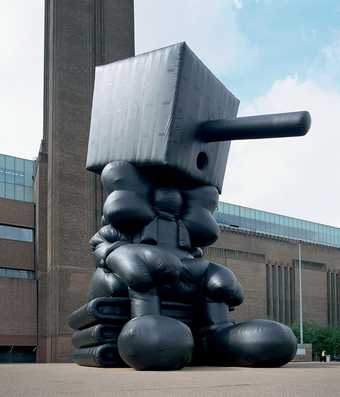
Paul McCarthy
Blockhead
Installation view at Tate Modern
Courtesy Hauser & Wirth Zürich London
© Paul McCarthy
Air has a privileged relation to the struggle of art with, or rather its striving to find ways of doing without, objects. More and more, and most conspicuously in the conceptual arena, art must refuse to be reduced to or mistaken for the objects which it has traditionally been called upon to bring into being. For more than a century it has struggled against the idolatry or enchantment of objects, preferring processes, especially vanishing, decomposition or evaporation to the precipitation of forms. Air has often been the carrier of this immaterialism. Perhaps the inaugurating work in this tradition is Marcel Duchamp’s 50cc of Paris Air 1919, a glass phial which he made for his friend Walter Arensberg, buying it from a pharmacist, after asking the chemist to pour away the liquid it contained and re-sealing it. In this work, both the container and the air inside it is a readymade. The gesture of emptying out the original contents of the flask substitutes nothingness for the original commodity on sale in the shop, a lesson insisted on in the parody of consumer choice offered by the designation “Paris Air”, as though its place of origin gave it a particular value or distinctiveness, in the same way as eau de cologne. So perhaps the air is not so much a readymade as a ready-to-hand emblem of unmaking. Because what the flask contains is absolutely arbitrary, the air here bringing forward the idea of not being there and, by extension, art’s capacity to summon and sustain this condition of the not-all-there, the next-to-nothing.
No object embodies art’s desire to have done with objects more than air. In fact, air has become a kind of allegory of art, or of its allergy to objects. “Immaterial sensibility is a gas,” Nicolas Bourriaud has written. To work with air is to wish to become it, to evaporate every particle of what would betray art into the condition of an object, while yet remaining exquisitely, infinitesimally intact in that very operation. If air is, as the seventeenth-century Irish scientist Robert Boyle put it, the “next Degree to nothing”, then art aspires to insinuate itself into that differentiating chink. For the ability not only to work with air, but also to identify with it, gives warrant to the claim that if art can even be nothing, then it can be anything. Art, like air, consists of nothing in particular; it has, and need have, no consistency with itself or anything else. Of course, this is also the thing that secures the distinctiveness of art. Everything else is stuck with the miserable finitude of having to be something in particular.

Damien Hirst
What Goes Up Must Come Down 1994
Ping-pong ball, hairdryer, Plexiglas container
30 x 30 cm
Courtesy Parkett, Damien Hirst
Air is neither on the side of the subject nor of the object. It has neither objecthood nor essence. It has no objecthood because it has no single form of being, manifesting itself in a multitude, and never less than a multitude, of traces and effects – the hiss of a tyre, the breath of a zephyr, the buffet of a gale, the vortex of leaves on a street corner. But these appearances are not the secondary expression of an essence any more than they are the properties of an object. The air is impression without presence.As art has sought to expand infinitely the range of its applications and operations, it has also sought to assume what might be called the illocative pull of the air away from the particularity of this or that place, its wish to propagate into everything. Much air art can trace its lineage to the Dimensionist Manifesto, published in Paris in 1936 in the form of a single-page insert in the magazine Revue N+1 by the Hungarian poet Károly Sirató and signed by Arp, Delaunay, Duchamp, Kandinsky, Moholy-Nagy, Picabia, Kandinsky and others. This manifesto aimed to extend art into all the available dimensions of space, in the interests of “Cosmic Art Vaporisation of Sculpture’’, and the requirement that “rigid matter is abolished and replaced by gazefied materials”. The most unpleasant associations of the idea of vaporisation were as yet still in the future in the mid-1930s, and the imperial cast of the demand that “instead of looking at objects of art, the person becomes the centre and the subject of creation” was perhaps less irresistibly evident than it may now appear. Nevertheless, for much of the twentieth century, the apparent relinquishment of being involved in an art of air has also been able to be an exercise in actual or imaginary conquest.
In much recent art, air has become the marker not of the difference between art and life, but of the aspiration of art to trespass beyond its assigned precincts, to approach and merge into the condition of “life”. One of the most influential post-war proponents of this idea was Yves Klein, fourth dan judo expert, Rosicrucian and Knight of the Order of St Sebastian, showman and occasional painter. From an early age, Klein had longed to join himself to the universal vacancy imaged in the overarching, cloudless blue sky, even resenting the flight of birds for vandalising the sky’s immaculate emptiness. The governing principle of his mysticism was the yen for expansion and dissolution, in an effort to dissolve all differences and distinctions in an immense cosmic unity. Realising that it was not possible for this condition to be simply or non-contradictorily given in art, he saw it as his duty as an artist to find images that could both materialise the immaterial and “impregnate” the viewer with a sensitivity to what lay beyond the bad dream of differentiated material existence, sensitivity being defined as “what exists beyond our being and yet always belongs to us”. Initially, he saw single colours, and the particularly pulsating shade of ultramarine blue he dubbed International Klein Blue, or IKB, as the best way of activating “zones of immaterial pictorial sensitivity”. But he realised within a couple of years (one wonders how it could have taken longer than a couple of minutes) that the transparency of empty air would be an even better aperture on to the void. Void was, in fact, put on at the Galerie Iris Clert in Paris in 1958. Though Void was universal, it was fortunately not homogenous, since this enabled Klein, like an estate agent of inspired canniness, to exchange zones of immaterial pictorial sensitivity for specified weights of gold leaf.
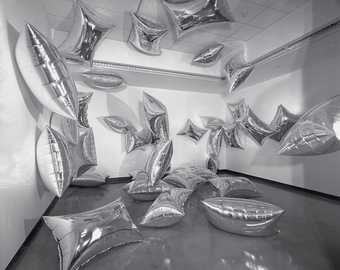
Andy Warhol
Silver Clouds 1966
Installed at The University Art Museum, Long Beach 1997
© Andy Warhol Foundation for the Visual Arts / Artists Rights Society (ARS), New York / DACS, London 2008
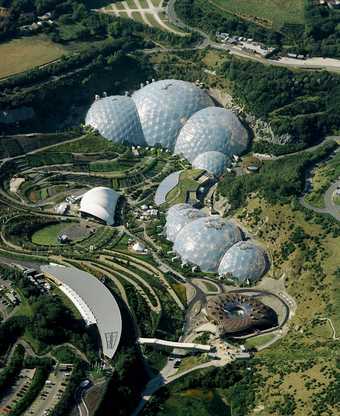
Nicholas Grimshaw
Biome conservatories at the Eden Project, Cornwall 2001
Photo: Sealand Aerial Photography
After his meeting with architect Werner Ruhnau around 1957, Klein entered his “pneumatic period”, which was consolidated over the next two years with a series of projects for and fantasies of a global “architecture of air”. In a pair of talks at the Sorbonne in June 1959, jointly entitled “L’evolution de l’art vers l’immatériel”, Klein set out his plans for all existing solid architecture to be dismantled and stored underground and for the climatic conditioning of all regions of the earth, which would allow human beings to live in a state of Edenic, if somewhat breezy, repose, reclining on sofas consisting of jets of compressed air. The house itself “must be built with the new material of ‘air’ blown into walls, dividers, roof, furniture”. The most important thing about his architectural programme was the stripping away of the roof.
Architects such as Ruhnau had been hindered, wrote Klein, “by the last obstacle that even a Mies van der Rohe hadn’t been able to overcome: the roof, the screen that separates us from the sky, from the blue sky”. In the artist’s visionary pneumatic architecture, the office of the roof would be performed by a layer of compressed air that would deflect dust and rainfall. His idea was to create a state of planetary pneumatic bliss, which would conduct human beings to a stage of universal levitation. As he promised in a speech in Düsseldorf: “We will become aerial men, we will experience the force of attraction upward, toward space, toward nowhere and everywhere at the same time; the force of earthly attraction thus mastered, we will literally levitate in total physical and spiritual freedom.”
Since Klein, it has increasingly been assumed that working with air is a good way to relinquish the dominative relation to objects that has contaminated art of the past. Robert Barry produced in 1969 a work called Inert Gas Series, which consisted of him releasing into the atmosphere above the Mojave Desert cylinders of xenon, helium and other so-called noble or unreactive gases. The point of using inert gases was evidently to have as little impact on the environment as possible: “I try not to manipulate reality,” Barry has said, “not to impose my preconceived grid or preconceived system on to reality. I, to use Heidegger’s phrase, let things be. What will happen, will happen. Let things be themselves.” Like the gas itself, the action distinguished itself by making no, or next to no, difference.
Other artists have given the imagined immateriality of the air a more spectral aspect. Ewa Kuryluk’s distinctive paintings on cloth suggested the title ‘Air People’ for the retrospective of her work in Warsaw in 2003. The Polish art critic Andrzej Wirth identifies these “air people”, cloth figures draped over bushes and trees, with the partisans who parachuted nightly into occupied Poland during the war, and takes them as emblems for the drifting, frameless, volatile nature of Kuryluk’s work, as “silhouettes of ‘people of air’… seem ready at any minute to fly into the unknown”.
Ann Veronica Janssens, who has turned in recent years to the creation of sculptures and environments made of mist, has said: “What interests me is what escapes me, not to try to keep it from escaping, but on the contrary to experience the ‘imperceptible’ and offer that experience to others.” The soft, virtual volatility of mist, clinging, but drifting, offers a virtuous “absence of authoritarian materiality, that effort to get out from under the tyranny of objects”. Janssens emphasises not the isolating characteristics of the artificial fogs she creates, but rather their capacity to dissolve: “Fog has contradictory effects on our vision. It makes every obstacle, all materiality, all contextual resistance, disappear, and at the same time it seems to bestow materiality and tactility on light… Bathed in light, we find ourselves transformed, blindly, one might say, and yet with no constraints or apparent limits.”
If air is “pure”, it is in a special way, for it is purely and specially compound. As Gerard Manley Hopkins put it, air is “fairly mixed/With, riddles, and is rife/In every least thing’s life”. It is in the nature of air not only to surround everything, but also to pervade everything, mixing and mingling with other gases, entering into compounds through the copulative appetite of oxygen.
There is another kind of work done on and through the air that, because it is less concerned with prolonging itself in its objectless integrity, allows air and art to compound in the advent of objects. One example is the inflatable. In comparison with the ethereal poiesis of the art of the open air, the rhetoric of the inflatable associates it with ironic and bathetic corporeality. The inflatable object is frail, delicate, but also ridiculous, always on the point of abject eruption and collapse. Paul McCarthy’s huge inflatable sculptures Blockhead and Daddies Bighead, installed outside Tate Modern in May 2003, were sinister, sleazy, parodic, cartoonish, melancholically deformed. Blockhead looked like a cartoon character on whom a sledgehammer or a saucepan has violently descended; but now the weapon has become the character’s head, and it seems to peer through the handle as though through a tank’s gun or a Dalek’s periscopic stalk. One could enter the giant sculpture and buy sweets; in the interior there was a loud and cavernous hiss from the air that was pumped in to keep the thing wheezily erect. Combined with the bizarre blowhole that formed part of the head, the suggestion seemed to be that the sculpture was struggling asthmatically to catch its breath.
Grander claims have sometimes been made for inflatable art and architecture, perhaps nowhere more, or more surprisingly, than in the exhibition ‘Structures gonflables’, mounted in March 1968 at the Musée d’Art Moderne de a Ville de Paris by architects associated with the Utopie group of urban theorists. The show gathered together an array of inflatable objects and structures, offering them as images of pop emancipation and ephemerality. Perhaps it is in part true that, as architectural historian Marc Dessauce maintains, “the inflatable ethos possessed a subversive constitution which recommended it to avant-garde practice”, for perhaps inflatable art was indeed an answer to the pervasive flatness of Marcuse’s era of one-dimensional man, since “it is as if the propensity to describe the epoch as lacking in relief had reflected itself in an exactly inverse manner, in an image of perpetual roundness and turgescence”. The French protests of May 1968 broke out just days after the exhibition closed, though a direct connection seems improbable. The associations of bubblegum and bouncy castle are never far away from inflatable air, and Dessauce is nearer the mark in claiming that pneumatic art and design ought to be seen as a grotesque exaggeration of the “pneumatic penetration of everyday life”, in automobile transport and air-conditioning:
Thus the formidable equalising power of air-flow, and our insatiable appetite for its therapeutic and uplifting value, could also be held accountable for a loss of texture, and the deep, aerodynamic stretching of urban fabric to the point of its separation, dispersion and constriction – like the shrivelled debris of a popped balloon strewn at the periphery of a defunct centre.
Inflatable art seems to forbid the unfettered dream of the immaterial. In inflatable art, air enters into composition, is folded or forced into new kinds of object, rather than invoking the spaces of the un-object. Earlier artistic allegories of the air were bulging with material forms, often those of birds, as, for example, Joachim Beuckelaer’s The Four Elements: Air, a Poultry Market With the Prodigal Son in the Background 1570. More recently, art has returned to this manner of representing air displaced into objects. A number of examples are discussed in the recent collection Going Aerial, edited by Monika Bakke (2006). Not surprisingly, the most interesting hybridisings of air are to be found in its section on breath-works, since breath embodies the transcoding or compounding of air much more readily than the volatilisation of things into the (imaginary) condition of air. Whether in the Breath Cultures 1999 of Sabrina Raaf, which grew into visible form the oral flora from participants who had breathed over Petri dishes, or her project Translator II: Grower 2004–5, in which a small robot moved around the walls of a room drawing shafts of “grass” in response to the fluctuating levels of carbon dioxide in the space, the air seems to mean the necessity for translatability, an existence only in the mediations of objects. Steve Heimbecker’s Wind Array Cascade Machine 2003 arises out of the artist’s experiences of the wind in the western Canadian prairies where he grew up, watching the progress of storms for hours as they drew near, and his recognition that “we do not actually hear the wind, but rather hear and see objects as they are affected by the wind, such as the wind in our ears (and our microphones), the wind through the leaves of a tree, a field of mature grain blowing in the wind, or even the swirling detritus around a city building”. The Wind Array Cascade Machine is 64 wind-pressure sensors covering an area of 25 metres square, which are designed to mimic the behaviour of a field of grain. The data collected by the sensors can be streamed, or recorded for later processing and transformation. In this work, air is not an empty ultimate condition, but a sort of “white box”, a transition from a variable but always determinate input to a variable but always determinate series of outputs. The machinery embodies the indefinite process whereby the air becomes itself by being made exterior to itself.
Air offers art two forms of being and becoming. There is first of all the annihilating dream of air as the ultimate refinement, the transcendental promise of matter subtilised to thin infinitude. But, after barely 300 years, the materiality, and therefore the finitude of the air has become unignorable, even as it has taught us that there are many more kinds of object, and ways of being an object, than we might have thought. Air is exchanging its ulteriority for exteriority. Instead of being the embodiment of a world beyond objects and bodies, air has become the mediated arena of the object. Air is no longer an ideal image for art, but an object for it to work on, and by which to be itself worked out, worked loose even from its self-identity. In its phantasmatic assimilation of itself to the uniform dream of air as pure dematerialisation, of matter terminally rarefied into space, art keeps itself narcissistically but anxiously entire. In propagating the air into objects, art stands a chance of propagating into something beside itself.

